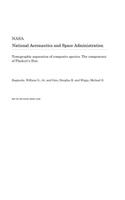
Tomographic Separation of Composite Spectra. the Components of Plaskett's Star
Series:
The UV photospheric lines of Plaskett's Star (HD 47129), a 14.4 day period, double lined O-type spectroscopic binary were analyzed. Archival data from IUE (17 spectra well distributed in orbital phase) were analyzed with several techniques. A cross correlation analysis, which showed that the secondary produces significant lines in the UV, indicates that the mass ratio is q = 1.18 + or - 0.12 (seco
NaN
VOLUME
English
Paperback

The UV photospheric lines of Plaskett's Star (HD 47129), a 14.4 day period, double lined O-type spectroscopic binary were analyzed. Archival data from IUE (17 spectra well distributed in orbital phase) were analyzed with several techniques. A cross correlation analysis, which showed that the secondary produces significant lines in the UV, indicates that the mass ratio is q = 1.18 + or - 0.12 (secondary slightly more massive). A tomography algorithm was used to produce the separate spectra of the two stars in six spectral regions. The interpolated spectral classifications of the primary and secondary, 07.3 I and 06.2 I, respectively, were estimated through a comparison of UV line ratios with those in spectral standard stars. The intensity ratio of the stars in the UV is 0.53 + or - 0.05 (primary brighter). The secondary lines appear rotationally broadened, and the projected rotational velocity V sin i for this star is estimated to be 310 + or - 20 km/s. The possible evolutionary history of this system is discussed through a comparison of the positions of the components and evolutionary tracks in the H-R diagram. Bagnuolo, William G., Jr. and Gies, Douglas R. and Wiggs, Michael S. Unspecified Center NSF AST-89-16110; NAG5-1218...
Price Comparison [India]
In This Series
Bestseller Manga
Trending NEWS




















